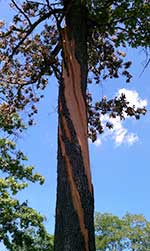Our Services
Tree Surgeries
Cabling, bracing, and lightning protection
Cabling and bracing (C&B) systems and lightning protection systems are installed into trees for increased safety and, ideally, prolonged tree life. Arborists install these systems into trees to prevent storm damage and to protect trees from lightning strikes. The hardware and the procedures involved in proper installation are usually expensive and time consuming, so they are generally reserved for high-value trees only.
Cabling
Cabling procedures permanently connect two or more high-level limbs with specialized cable material. The cables provide support to weak or potentially dangerous limbs. Branches subject to cabling are those that pose a threat to property or people, e.g. where wind stress or accumulated snow loads may cause primary branches to break and fall to the ground.
Bracing
Bracing procedures utilize steel rods to provide rigid support for a tree. The rods are typically installed in the lower (larger) portions of the tree and they reinforce weak or split crotches and strengthen decayed areas. Proper bracing is used in combination with cabling – not as a substitution.

Lightning Protection
A bolt of lightning can destroy a tree in less than a second, and can cause serious harm to people or animals below. Consider having a lightning protection system installed if you have a high-value tree that stands taller than others in its area or is located alone in an open landscape or on the crest of a hill. Such trees have a high propensity for lightning strikes.
Installation of a lightning protection system involves the placement of copper conductors into the highest portions of the tree, down the main branches and trunks, and then out beyond the tree’s dripline where they are eventually grounded. Lightning bolts and electrical charges are carried via the conductors safely away from the tree and into the ground.